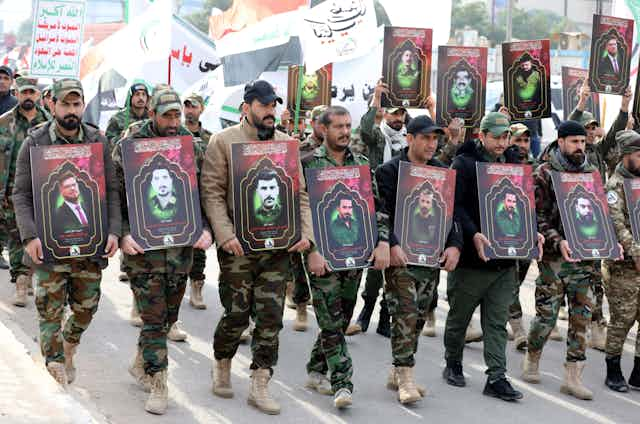It took the US several days to respond to the January 28 attack on its military base in Jordan that killed three of its service personnel. But when it did, it hit at least 85 targets across Iraq and Syria.
The Pentagon was careful not to directly attack Iran itself, but it targeted Iranian-backed groups which have been conducting raids on US military assets in the region since before Hamas launched its attack on Israel on October 7.
The US strikes were carefully calibrated to avoid escalation. The five days between the attack on the Tower 22 US base in Jordan and the US airstrikes on February 2 gave Iran and its proxies time to move people and high-value assets.
This retaliation wasn’t about body counts, it was about US president Joe Biden showing Iran – and the American electorate – that it doesn’t do to mess with the US. It was a classic shot across the bows.
But who are these groups that Iran can rely on to act in its interests and how much of a threat do they pose to regional security?

Iran’s foreign policy over nearly five decades since the 1979 revolution has had several key objectives. It wants to remove the US from the Middle East and to replace it as the guarantor of regional security.
It has worked to boost the fortunes of Shia groups in the region, working directly against Saudi Arabia’s Sunni proxies, as seen in the conflict in Yemen. And it refuses to recognise the state of Israel, instead working with Palestinian groups such as Hamas and Hezbollah to pressure the Jewish state.
Quds Force
The Quds Force is part of the Iran’s Islamic Revolutionary Guard Corps (IRGC) and is the IRGC’s primary vehicle for foreign affairs. According to the Council on Foreign Relations, Quds is largely responsible for providing training, weapons, money and military advice to a range of groups in the so-called “Axis of Resistance”.
Quds was led by General Qasem Soleimani, who had oversight of Shia armed groups in Iraq and Syria as well as wielding a significant amount of influence with Hezbollah in Lebanon. Soleimani was killed in a US drone strike in the Iraqi capital, Baghdad, on January 3 2020.
He was succeeded by his longtime deputy Ismail Qaani, who had gained extensive experience in organising and supporting insurgent groups in Afghanistan.
Syria
In 2021, Iran’s supreme leader, Ayatollah Ali Khamenei, estimated that the IRGC had established 82 fighting units in Syria with up to 70,000 fighters. Many of these have been recruited since 2011 to help the Shia regime of Bashar al-Assad combat insurgents there.
Quds activities in Syria are reportedly overseen by Khalil Zahedi, nicknamed Abu Mahdi al-Zahdi. Working through regional subordinates, he controls a number of armed groups, including Liwa al-Quds, Lebanese Hezbollah, Fatemiyoun Brigade, Zainebiyoun Brigade, Hezbollah al-Nujaba, Liwa al-Baqir and Kata’ib al-Imam Ali.

Iran’s principal aims in Syria are to keep the Assad regime in power, maximise Iranian influence, protect Shia minorities and reduce and – if possible – eliminate the US presence in Syria. It also aims to create the conditions for a possible encirclement of Israel by occupying strategic position around the Golan heights.
Iraq
In Iraq, since the US invasion, Iran-backed armed groups come under an umbrella organisation called the Popular Mobilisation Forces (PMF) or Quwwāt al-Ḥashd ash-Shaʿbī. The PMF claims to have as many as 230,000 fighters, mainly Shia. The PMF was founded in 2014 when Iraq’s Shia religious leader, Grand Ayatollah Ali al-Sistani issued a fatwa calling on Iraqis to defend their country after the Iraqi army collapsed and Islamic State took the northern province of Mosul.
In 2018 the PMF was incorporated into Iraq’s armed forces as an auxiliary force. As a result its wages are paid by the Iraqi military, but the Iranian government lacks proper command and control over the PMF. The same year PMF’s political wing contested elections in Iraq, coming second in the poll. It also performed well in Iraq’s 2023 regional elections and is now believed to wield considerable control in both the Iraqi parliament and the country’s supreme court.
Its military forces are now believed to be active in Kurdistan as part of an overall strategy to force the US to withdraw from the region.
Lebanon
North of Israel’s border with Lebanon, Hezbollah has been conducting military operations against Israel for many years and since October 7 clashes between Hezbollah forces and the Israel Defence Forces have become almost daily occurences.
Hezbollah (Party of God) was formed in 1982 to fight against the Israeli invasion of Lebanon. It was trained and equipped by Iran, which continues to provide practically all of its financial and military resources. In its 1985 manifesto, it vowed to expel western powers from Lebanon, called for the destruction of Israel state and pledged allegiance to Iran’s supreme leader.
In 2021 Hezbollah’s leader, Hassan Nasrallah, claimed that the organisation has 100,000 trained fighters, but estimates as to its actual strength vary considerably.
While heavily involved both politically and economically in Lebanon, Hezbollah is also active throughout the region, doing Iran’s business rather than looking after Lebanese interests.
Major headache for the west
As can be seen with the recent attacks by Iran-backed Houthi rebels in Yemen on shipping in the Red Sea (the Houthis are armed and trained by Iran as part of a civil war against the Sunni national government backed by Saudi Arabia), dealing with Iran’s proxies throughout the Middle East is a serious challenge.
Many of these groups now wield significant political influence in the countries in which they are embedded, so confronting them is not simply a military exercise. And, as the dramatic rise in tensions in the region following the assault by Hamas on Israel (also planned with Iranian help) suggests, Iran is capable of fomenting trouble for the west almost at will across the region.

